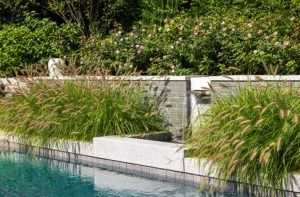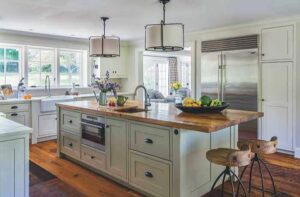Artistry: Painter Eva Lundsager
August 13, 2018
Hovering somewhere between abstraction and reality, Eva Lundsager’s vivid, color-saturated canvases evoke a sense of both familiarity and adventure.
Text by Robert Kiener
Page through Eva Lundsager’s rich, varied, and colorful portfolio of her much-praised work over the last thirty years, and it’s clear why one reviewer noted, “Lundsager takes advantage of everything paint can do.”
The artist, who lives in Brookline, Massachusetts, and has a studio in nearby Somerville, brushes, drips, pours, layers, glazes, and “doodles” paint to produce her abstract works. “I love to experiment with paint,” she says. “I may begin a painting by laying a stretched canvas on the floor and dripping very liquid paint onto it; then I’ll lift it or turn it to let the paint drip upward, as if it is defying gravity. After it’s dry, I may place paint over paint and add tiny brushstrokes as well as bolder swatches of paint. My work is all about mark making, spontaneity, and the possibilities—the freedom—of abstract art.”
As she talks about her process, Lundsager describes being influenced by legendary artists and including “bits and pieces” of their techniques in her work. “I love Mark Rothko’s thin washes of paints, Morris Louis’s streaks, Helen Frankenthaler’s use of tiny, detailed brush strokes as well as Cézanne’s more heavily worked brush strokes.” Many of her works display her own broad knowledge of and love for the history of painting. “It’s a language I admire,” she says.
The fifty-eight-year-old Lundsager earned a BA in art from the University of Maryland and her MFA from Hunter College, and received a Guggenheim Fellowship in painting. Her work has been featured in numerous one-woman and group exhibitions and is included in many corporate collections and in the permanent collections of the Dallas Museum of Art, the Saint Louis Art Museum, and others. A compendium of her watercolors, Ascendosphere, was published by Regency Arts Press in 2009.
Although she calls her 330-square-foot studio “modest,” she admits that, “Every time I walk into this space, no matter how many problems I may have, I am instantly happy to be here. I know it’s because I love doing what I do: looking for images and trying to make two-dimensional representations of complex thoughts or feelings. I also love the surprise, and the privilege, of making art.”
She is currently working on three five-by-seven-foot oil paintings that lean against a studio wall and are propped up off the floor on old coffee cans. “I move the paintings around while I work on them, letting the paint drip in a controlled manner until I produce something I am happy with,” she explains. “Then I may put them on the wall and finish them. Or they may sit while I change my direction. I may even come in a day later and scrape or sand off what I’ve done previously. I like going from one canvas to the other as I solve problems and make discoveries.”
Those “discoveries” are what appeal to many of her collectors. John Smith, director of the Rhode Island School of Design’s Museum of Art and a longtime owner of Lundsager’s work, says, “There’s so much depth in Eva’s abstract paintings. I have one of her works that, no matter where I have lived, I have always placed in a prominent location. That’s because I never fail to see new meanings, new possibilities in it. There’s a real richness to her work that continues to intrigue me.”
Another collector, this one in Manhattan, agrees. “Her use of color and form has so much complexity. And even though ours is an abstract painting, there’s a combination of elements that evoke the sky or space, the landscape, and even the water.”
When reminded that one writer noted that her work “hovers between landscape and abstraction,” Lundsager nods and admits, “That’s interesting. I’ve always thought of abstract painting as an escape—or a window—into another realm, which could be landscape or space.”
She points out that many of her paintings have at least a representation of a horizon line. “The paintings are suggestive of a familiar space, but when you start scrutinizing marks and lines, nothing becomes recognizable. It all goes back to a brush stroke or drip or pour or smear of paint. You think you might know what it is, but you don’t. I like the familiar but the not completely known.”
Editor’s Note: To see more of Eva Lundsager’s work, visit evalundsager.com.
Share
![NEH-Logo_Black[1] NEH-Logo_Black[1]](https://www.nehomemag.com/wp-content/uploads/2022/08/NEH-Logo_Black1-300x162.jpg)
















You must be logged in to post a comment.